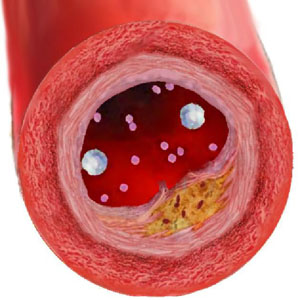Cholesterol is a lipid, a type of fat that is found in the bloodstream and the cells of the body, is an important component of a healthy organism; cholesterol is used in our metabolism to produce cell membranes and some hormones, as well as participating in other vital processes in the body.
Refers to two types of cholesterol, the good and the bad, but cholesterol is actually one single and this classification refers to the lipoprotein that transports it.
LDL or low density lipoprotein is associated with the “bad cholesterol” because it makes the transport of cholesterol into artery walls and thence to the tissues, and HDL or high-density lipoprotein that transports cholesterol from tissues to the liver for metabolism, is associated with “good cholesterol”.
Hypercholesterolemia or too much cholesterol in the blood is a major risk for coronary heart disease that can lead to a heart attack, is also a risk factor for stroke.
However, it is normal to have cholesterol, is essential for the functioning of our body, being associated with sex hormones: testosterone in men and progesterone in women and steroid hormones involved in a variety of physiological mechanisms, including those governing inflammation, the immune system, the metabolism of carbohydrates and characterizing the response to stress.
The blood cholesterol levels can be known through a blood test, can be considered the following information as a general pattern to see if the values are within the normal range or not.
Total cholesterol levels
- Less than 200 mg/dL level “desirable” that exposes you to less risk of heart disease.
- 200-239 mg/dL high limit. A total cholesterol of 200 mg/dL or more increases the risk.
- 240 mg / dL and cholesterol “high”. A person with this level has more than twice the risk that a person with desirable level.
Levels of LDL “bad” or “low-density lipoprotein”
- Less than 100 mg/dL Optimal.
- 100-129 mg /dL near or above the optimum value.
- 130-159 mg/dL high limit.
- 160-189 mg/dL High.
- 190 mg/dL and above very high.
Levels of HDL “good” or “high-density lipoprotein”
- Less than 40 mg/dL (men), less than 50 mg/dL (women) Low HDL cholesterol, this level increases the risk of cardiovascular disease.
- 60 mg/dL and high HDL cholesterol (optimal). This level reduces the risk of cardiovascular disease.
The excess or deficiency of any of the cholesterol-carrying lipoproteins or may cause health problems, the ideal is to balance these substances to prevent possible heart problems or stroke. Lifestyle and diet are two of the key factors to achieve that balance and harmony that can make a difference in our health.
The formula is simple: eat vegetables, decrease consumption of red meat, smoking cessation, exercise and realize that prevention is the best medicine. General guidelines for healthy living that we all consider to be healthy and strong without being afraid to cholesterol, bad guy of course.
If you have problems with your blood cholesterol levels, see a doctor for evaluation, diagnosis and appropriate treatment.
